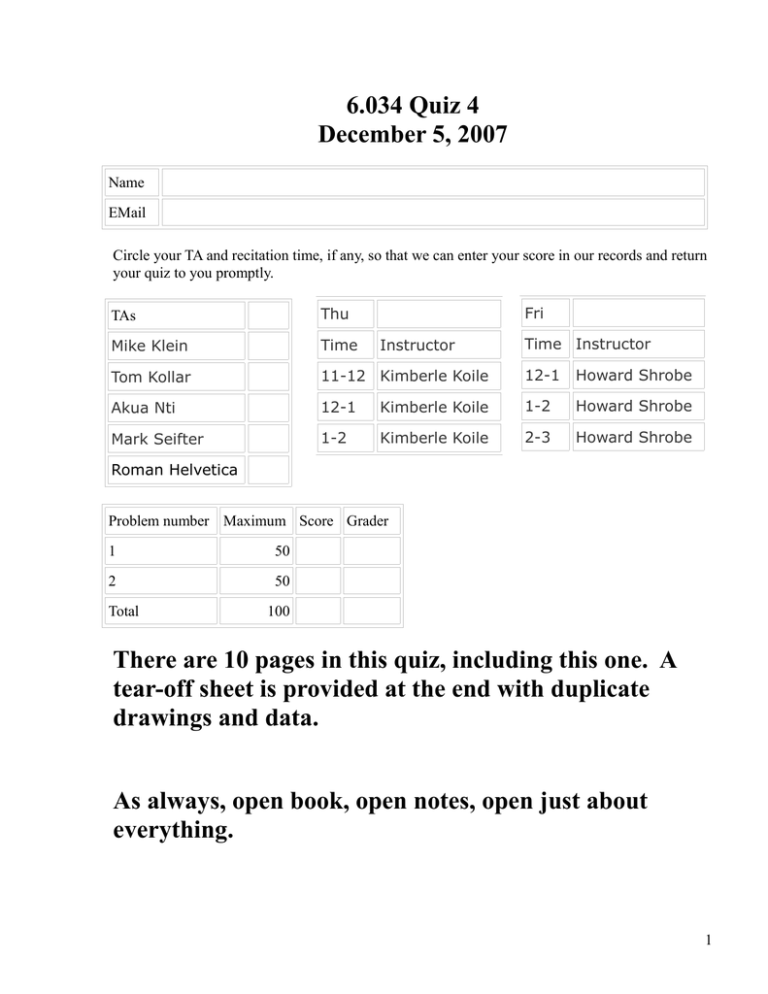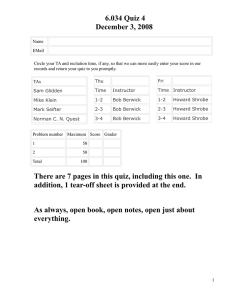6.034 Quiz 4 December 5, 2007
advertisement

6.034 Quiz 4 December 5, 2007 Name EMail Circle your TA and recitation time, if any, so that we can enter your score in our records and return your quiz to you promptly. Fri TAs Thu Mike Klein Time Tom Kollar 11-12 Kimberle Koile 12-1 Howard Shrobe Akua Nti 12-1 Kimberle Koile 1-2 Howard Shrobe Mark Seifter 1-2 Kimberle Koile 2-3 Howard Shrobe Instructor Time Instructor Roman Helvetica Problem number Maximum Score Grader 1 50 2 50 Total 100 There are 10 pages in this quiz, including this one. A tear-off sheet is provided at the end with duplicate drawings and data. As always, open book, open notes, open just about everything. 1 Question 1: Support Vector Machines (50 points) Sick of hearing music that you don't like, you decide to train a support vector machine classifier to determine whether you will like a new song; that way you can write a program to randomly play music that you will like. You train your program on a number of songs you hear on the radio, as well as songs from your personal music collection. Two of the features you give to the SVM are the number of occurrences of the word “love” and the number of occurrences of obscene words. The data points are shown below: 5 4 Love 3 2 1 0 0 1 2 3 4 5 Obscene The points labeled '+' are the songs you like and the points labeled '–' are the songs you don't like. Part A1 (12 points) A1a: You do your first analysis using a linear kernel the decision boundary found by the SVM. K x , x ' = x⋅x ' . On the above plot, draw A1b: Also, circle the support vectors. 2 What is the final classifier. Your answer is to be an arithmetic expression in terms of x (obscene word axis) and y (love axis) and constants. What are the weights α for the support vectors? What is the weight, α , for the vector [1, 4]? Part A2 (9 points) Now you decide to eliminate two of the sample vectors as shown below. 3 5 4 Love 3 2 1 0 0 1 2 3 4 5 Obscene Circle the support vectors. Again, you use a linear Kernel. What is the final classifier? Your answer is to be an arithmetic expression in terms of x (obscene word axis) and y (love axis) and constants. What are the weights α for the support vectors? 4 Part A3 (9 points) Now you decide to restore the two vectors eliminated in part B, but you discover a measurement error, so your data is really as shown below. 5 4 Love 3 2 1 0 0 1 2 3 4 5 Obscene Circle the support vectors. Again, you use a linear Kernel. What is the final classifier? Your answer is to be an arithmetic expression in terms of x (obscene word axis) and y (love axis) and constants. What are the weights α for the support vectors? 5 Part B (15 points) You decide to try an alternative approach with the following data: To get a better understanding of how various kernels handle your new approach, you try all ten provided in the demonstration program. You discover, interestingly, that 6 of the 10 produce results that are just about indistinguishable, so only five different pictures are shown in the accompanying diagram. Fill in the table below with the appropriate diagram label from the separate sheet containing SVM outputs. Note that 6 of your answers in the 10 boxes will be the same and 4 will be different from all the others. V1⋅V21 V1⋅V212 V1⋅V213 V1⋅V214 V1⋅V215 2 e −∥V1−V2∥ 2.0 2 e −∥V1−V2∥ 0.5 2 e −∥V1−V2∥ 0.22 2 e −∥V1−V2∥ 0.12 2 e −∥V1−V2∥ 0.06 6 A B D E C Part C (5 points) Of the kernels tried in part B, one does not succeed in properly classifying all the examples. Among the rest, identify the kernel that is likely to provide the worst results when applied to test data: Why? 7 Question 2 Boosting (50 points) In this problem you will use Adaboost to classify this data: In all parts of the problem, use these stubs as possible classifiers. When choosing classifiers, break ties in order. h1: x < 2.5 h2: y > 1.5 h3: y > 3.5 8 The weights start evenly distributed: 1/8 1/8 1/8 1/8 1/8 1/8 1/8 1/8 w1 w2 w3 w4 w5 w6 w7 w8 Part A, Step 1 (10 points) Circle the first classifier that Adaboost picks. h1 h2 h3 What is the first classifier's α? What are the new weights? w1 w2 w3 w4 w5 w6 w7 w8 9 Part B, Step 2: (10 points) Circle the second classifier that Adaboost picks. h1 h2 h3 What is the second classifier's α? What are the new weights? w1 w2 w3 w4 w5 w6 w7 w8 Part C, Step 3: (10 points) Circle the third classifier that Adaboost picks. h1 h2 h3 What is the third classifier's α? Part D (10 points) What is the error rate of the Adaboost classifier made up of the above three classifiers? Part E (10 points) What is the error rate for a simple vote among the three classifiers? (Like Adaboost with all α's equal.) 10 Tear off sheet—you need not hand this in. h1: x < 2.5 h2: y > 1.5 h3: y > 3.5 11 Tear off sheet—you need not hand this in. A D B C E 12 Table of natural logs n 0.25 0.50 0.75 1.00 1.25 1.50 1.75 2.00 2.25 2.50 2.75 3.00 3.25 3.50 3.75 4.00 4.25 4.50 4.75 5.00 5.25 5.50 5.75 6.00 6.25 6.50 6.75 7.00 7.25 7.50 7.75 8.00 8.25 8.50 8.75 9.00 9.25 9.50 9.75 10.00 ln(n) -1.39 -0.69 -0.29 0.00 0.22 0.41 0.56 0.69 0.81 0.92 1.01 1.10 1.18 1.25 1.32 1.39 1.45 1.50 1.56 1.61 1.66 1.70 1.75 1.79 1.83 1.87 1.91 1.95 1.98 2.01 2.05 2.08 2.11 2.14 2.17 2.20 2.22 2.25 2.28 2.30 n 10.25 10.50 10.75 11.00 11.25 11.50 11.75 12.00 12.25 12.50 12.75 13.00 13.25 13.50 13.75 14.00 14.25 14.50 14.75 15.00 15.25 15.50 15.75 16.00 16.25 16.50 16.75 17.00 17.25 17.50 17.75 18.00 18.25 18.50 18.75 19.00 19.25 19.50 19.75 20.00 ln(n) 2.33 2.35 2.37 2.40 2.42 2.44 2.46 2.48 2.51 2.53 2.55 2.56 2.58 2.60 2.62 2.64 2.66 2.67 2.69 2.71 2.72 2.74 2.76 2.77 2.79 2.80 2.82 2.83 2.85 2.86 2.88 2.89 2.90 2.92 2.93 2.94 2.96 2.97 2.98 3.00 13 MIT OpenCourseWare http://ocw.mit.edu 6.034 Artificial Intelligence Fall 2010 For information about citing these materials or our Terms of Use, visit: http://ocw.mit.edu/terms.





